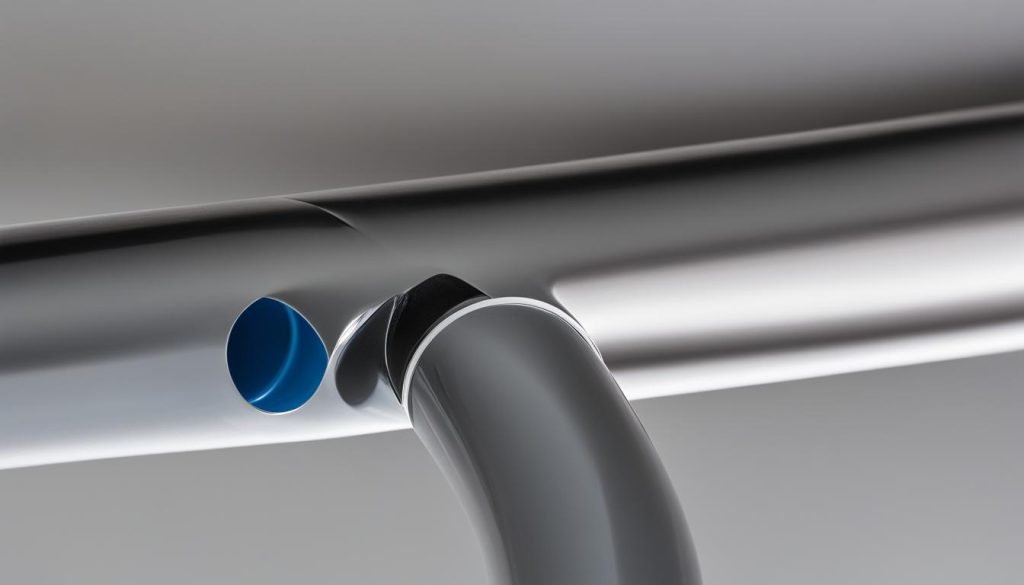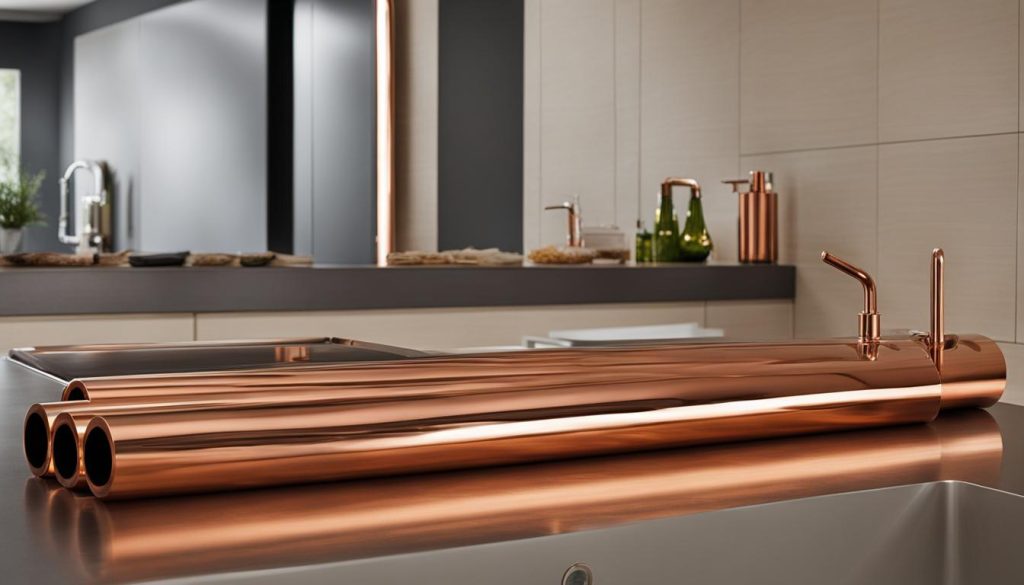Modern Plumbing Choices in New Homes
Did you know that the type of plumbing used in new homes can greatly impact their efficiency and longevity? As construction methods evolve, so do the materials and technology used in plumbing systems. From innovative piping choices to modern fixtures, staying up-to-date with the latest advancements can ensure optimal performance and code compliance for your new home.
Key Takeaways:
- Understanding different types of plumbing materials is crucial for new home construction.
- PEX pipes are affordable, flexible, and ideal for water supply lines in new homes.
- PVC pipes are commonly used for drain, waste, and vent systems in residential constructions.
- ABS pipes provide durability for drain, waste, and vent systems in new homes.
- Copper pipes remain a popular choice for water supply lines due to their long lifespan.
PEX Pipes: Ideal for Water Supply Lines
When it comes to water supply lines in new homes, PEX pipes are the go-to choice for builders and homeowners alike. PEX, or polyethylene cross-linked pipe, offers a range of benefits that make it ideal for residential plumbing systems.
One of the key advantages of PEX plumbing is its affordability. Compared to other piping materials, such as copper or PVC, PEX pipes are cost-effective without compromising on quality. This makes them a popular choice, especially in large-scale construction projects where budget considerations are crucial.
Another major advantage of PEX pipes is their flexibility. PEX tubing can be easily bent and shaped to fit around obstacles, making installation a breeze. This flexibility also allows for fewer fittings and joints, reducing the potential for leaks and improving overall system efficiency.
PEX pipes are resistant to rust and corrosion, ensuring that the water supply remains clean and safe. With PEX, you don’t have to worry about any contaminants leaching into your water, giving you peace of mind.
To further enhance convenience, PEX pipes are color-coded, making it easy to identify hot and cold water lines. This eliminates any confusion during installation or repairs, saving you time and effort.
PEX plumbing offers multiple connection methods, providing flexibility and adaptability. Whether you prefer crimp rings, push-to-connect fittings, or expansion methods, there is a PEX connection method to suit your needs. And with advancements like Uponor AquaPEX tubing, which is specifically designed for potable water applications, you can trust in the safety and reliability of your PEX water supply lines.
To ensure individual shut-off valves for each fixture, PEX manifolds can be incorporated into the plumbing system. This allows for easier repairs and maintenance, as you can isolate specific fixtures without disrupting the entire water supply.
Overall, PEX pipes offer a cost-effective, flexible, and reliable solution for water supply lines in new homes. With their numerous benefits and ease of installation, it’s no wonder that PEX plumbing continues to gain popularity in the residential construction industry.
Stay tuned for the next section where we discuss another popular plumbing material: PVC pipes for drain, waste, and vent systems.
PVC Pipes: Ideal for Drain, Waste, and Vent Systems
When it comes to the plumbing system in new homes, PVC pipes play a crucial role in ensuring efficient and reliable drainage, waste management, and ventilation. PVC, short for polyvinyl chloride, is a durable and versatile material that offers several benefits for residential plumbing systems.
PVC pipes are specifically designed for low-temperature and low-pressure applications, making them perfect for drain lines, waste disposal, and vent systems. However, it’s important to note that PVC pipes are not suitable for highly pressurized water supply lines or hot water.
One of the key advantages of PVC pipes is their affordability. Compared to other plumbing materials, such as copper or stainless steel, PVC pipes are cost-effective and readily available. This makes them a popular choice for new home constructions where budget considerations are crucial.
Another advantage of PVC pipes is their resistance to corrosion. Unlike metal pipes that can rust or corrode over time, PVC pipes are highly resistant to chemical reactions, ensuring long-lasting durability and optimal performance. Additionally, PVC pipes are lightweight and easy to handle, making installation and repairs hassle-free.
PVC plumbing systems often use DWV pipes, which stands for Drain, Waste, and Vent. These pipes are specifically designed to handle the flow of wastewater, removing it efficiently from various fixtures in your home, such as sinks, toilets, and showers. The DWV system also includes vent pipes that allow air to enter the plumbing system, preventing the buildup of air pressure and ensuring smooth drainage.
When it comes to installation, PVC pipes offer flexibility and ease. They are available in various sizes, allowing plumbers to select the most suitable diameter for specific applications. PVC pipes can be easily cut and connected using PVC glue or solvent cement, ensuring secure and leak-free joints.
To illustrate the benefits of PVC pipes in drain, waste, and vent systems, here’s a comparison of different plumbing materials:
| Plumbing Material | Durability | Resistance to Corrosion | Affordability | Installation |
|---|---|---|---|---|
| PVC | High | Excellent | Affordable | Easy, with PVC glue |
| Copper | High | Excellent | Expensive | Requires soldering joints |
| Galvanized Steel | Moderate | Prone to rust | Affordable | Threaded connections |
As you can see from the comparison table, PVC pipes offer a perfect balance of durability, corrosion resistance, affordability, and ease of installation. They are a reliable choice for drain, waste, and vent systems in new homes, ensuring optimal performance and longevity.
ABS Pipes: Suitable for Drain, Waste, and Vent Systems
When it comes to drain, waste, and vent systems in new homes, ABS pipes offer a reliable and durable solution. ABS, or acrylonitrile butadiene styrene, pipes are similar in size and function to PVC pipes but are slightly more resilient in high-impact situations.
ABS pipes are widely used in indoor plumbing applications and are suitable for drain lines, waste pipes, and vent systems. They provide excellent performance, ensuring efficient and effective waste management in residential buildings.
The Advantages of ABS Pipes
- Resilience: ABS pipes are known for their durability and ability to withstand high-impact situations. This makes them an excellent choice for drain lines, where occasional physical stress can occur.
- Chemical Resistance: ABS pipes are resistant to a wide range of chemicals, making them ideal for use in drain, waste, and vent systems.
- Easy Installation: ABS pipes are lightweight and easy to handle, making installation quick and hassle-free. They can be easily cut to the required length and connected using compatible ABS pipes and fittings.
- Cost-effective: ABS pipes offer excellent value for money, as they are an affordable plumbing option for new homes.
Considerations for ABS Pipes
While ABS pipes have many benefits, there are a few considerations to keep in mind:
- Sunlight Exposure: ABS pipes should not be exposed to direct sunlight for extended periods, as sunlight can cause their surface to deteriorate. Therefore, ABS pipes are best suited for indoor plumbing applications.
Overall, ABS pipes are a reliable choice for drain, waste, and vent systems in new homes. Their durability, chemical resistance, and ease of installation make them a popular option among plumbing professionals.
Copper Pipes: Ideal for Water Supply Lines
Copper pipes have long been a trusted choice for water supply lines in both new and older homes. The durability, reliability, and longevity of copper plumbing make it a popular option among homeowners and professionals alike.
One of the key advantages of copper pipes is their ability to maintain the quality of the water they carry. Unlike some other materials, copper does not leach harmful substances into the water, ensuring that you have safe and clean drinking water.
Installation of copper pipes requires professional expertise. Soldering joints using a propane torch is necessary to create secure connections that can withstand the water pressure. This ensures a watertight seal that minimizes the risk of leaks or bursts.
Copper pipes are commonly used for water supply lines in sinks, showers, tubs, and other fixtures throughout the home. Their flexibility and malleability make them easy to work with, allowing for versatile installation options.
Copper plumbing is known for its longevity, often outlasting other pipe materials. With proper maintenance and care, copper pipes can provide reliable water supply for decades, making them a cost-effective investment over time.
When it comes to copper pipe brands, Straight Copper Pipe by Kobe Wieland is a trusted name in the industry. Their high-quality copper pipes ensure excellent performance and durability, meeting the demands of modern plumbing systems.
Advantages of Copper Plumbing:
- Durable and reliable
- Does not leach harmful substances into the water
- Requires professional installation for secure joints
- Flexible and malleable for versatile installation
- Long lifespan with proper maintenance
A Comparison of Different Plumbing Materials
| Plumbing Material | Advantages | Disadvantages |
|---|---|---|
| Copper | Durable, reliable, safe for drinking water | Requires professional installation, higher cost |
| PEX | Flexible, easy to install, affordable | Possible expansion and contraction, may not be recyclable in all areas |
| PVC | Affordable, resistant to corrosion | Not suitable for high-pressure or hot water |
| ABS | Durable, impact-resistant | Not suitable for direct sunlight exposure |
| Galvanized | Lead-free alternative | Prone to rusting over time |
| Cast Iron | Durable for sewer and drainage systems | Heavy and more expensive |
Galvanized and Cast Iron Pipes: Older Alternatives
When it comes to plumbing in older homes, galvanized steel and cast iron pipes were once commonly used but are now less common in new constructions. Galvanized steel pipes were a popular choice for water supply lines and drain systems, providing a lead-free alternative to other materials. However, over time, these pipes are prone to rusting, which can lead to diminished water flow and potential leaks.
Cast iron pipes, on the other hand, were primarily used for sewer and drainage purposes. While durable and known for their longevity, cast iron pipes can be heavy and difficult to work with during installation or repairs. These pipes were commonly found in older homes, but advancements in plumbing materials have led to their replacement with more modern and efficient options in new constructions.
Today, new homes are more likely to feature materials such as PEX, PVC, or copper for their plumbing needs. PEX pipes offer flexibility, affordability, and easy installation for water supply lines, making them a popular choice among builders and homeowners. PVC pipes, specifically designed for drain, waste, and vent systems, offer affordability and resistance to corrosion. Copper pipes, known for their durability and long lifespan, remain an ideal option for water supply lines in both new and older homes.
- Investing Wisely: How Windows & Doors in Boost Property Value and Financial Health - April 24, 2025
- The Financial Impact of Personal Injuries: Why Legal Help Matters for Business Owners - April 16, 2025
- The Hidden Financial Costs of Domestic Assault: What Business Owners Need to Know - April 16, 2025













